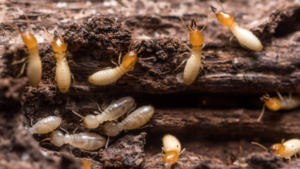Physical Address
23,24,25 & 26, 2nd Floor, Software Technology Park India, Opp: Garware Stadium,MIDC, Chikalthana, Aurangabad, Maharashtra – 431001 India
Physical Address
23,24,25 & 26, 2nd Floor, Software Technology Park India, Opp: Garware Stadium,MIDC, Chikalthana, Aurangabad, Maharashtra – 431001 India

By Aayushi Sharma
A recent study has found that warmer conditions increase termites’ activity to decompose wood at a much higher rate. It is observed that for each 10 degrees Celsius increase in temperature, the termite’s decomposition activity goes up to seven times.
What are termites? Why do they eat wood?
Termites are insects that consume a wide variety of decaying plant material, specially in the form of wood, soil humus, and leaf litter. There are around 3,000 species of termites across the world which includes the ones that consume plant material and even soil. Yet, the most common of them are the wood-eating termites.
Termites eat wood to derive the cellulose and nutrients which they need to survive. Protozoa and bacteria are present in their gut which allow them to break down the cellulose fibers in wood. These organisms turn these cellulose fibers into a nutritious meal and allow termites access to a food source that’s largely ignored by other species.
Role of termites in the ecosystem
Termites are major detritivores, particularly in the subtropical and tropical regions, and their recycling of wood and plant matter is of considerable ecological importance. They are among the most successful groups of insects on Earth, colonizing most landmasses except Antarctica. Termites are of significant interest in the promotion of ecosystem services.
How is rising global temperature affecting termite activity?
The research revealed that “as the Earth gets warmer, termites will rapidly spread across the world”. This would again, lead to a further rise in global temperatures, because termites while consuming deadwood, release carbon into the atmosphere.
According to the researchers, the termites’ ability to decompose dead wood — dead parts of trees that contain carbon — makes them an important part of the planet’s ecosystem and that’s why the study focused on them.
Highlights of the study
For the research, more than 100 scientists placed blocks of wood at 133 sites in six different continents (except in Antarctica), where bacteria, fungi, and termites consume dead wood. The speed at which the wooden blocks were eaten in different climates was then measured. As expected, both microbes and termites decomposed the pieces but it was found that there was a disproportionately higher increase in the insects’ decaying activity at higher temperatures. For example, In the region where the temperature remains 30 degrees Celsius, termites eat wood seven times faster than in places with 20 degrees Celsius.
The researchers also observed that these wood-eating termites were able to survive in warm and dry conditions, unlike microbes that need water to grow. Therefore, with “tropicalization (i.e., warming shifts to tropical climates), termite wood decay will likely increase as termites access more of Earth’s surface.”
“This study is one of the first that connects the dots among a species’ movement, changes in an ecosystem process, and climate change to show that the movement of an organism as small as a termite can cascade to impact the rate that wood—a global carbon stock—is decomposed,” Aimée Classen, a biologist at University of Michigan and co-author of the study, said in a statement.
Adverse impacts of increasing termite activity due to climate change
Climate change and environmental degradation, together with increased global trade, increase the opportunities for the introduction, spread, and persistence of invasive species.
According to a report “12 of the world’s 13 most invasive termite species could increase significantly in distribution by 2050 given Earth’s current temperature trajectories.” The study has also shown that climate change might be leading to an increase in the number of termites.
The combined threat posed by climate change and invasive species is fast growing. Evidence shows that warming environments as a result of climate change are not only affecting invasive termite distribution but also contributing to hybridization among invasive termite species.
Apart from the economic effects and damage caused to wooden structures, invasive termite also invades unoccupied natural areas and also has the capability to significantly alter the ecological balance of the invaded habitats.
It ring-barks and kills living trees and causes serious economic damage to various crop trees which includes mango, cocoa, coconut, and timber plantations. Their large populations are a threat to infrastructure as they are capable of tunneling through various materials in the search of their food.
Mastotermes darwiniensis, one of the most destructive termite species in the world, is likely to increase its range size by 55%–85% globally.
Increases in termite invasions lead to higher methane emissions, which drives global warming. This further leads to more termite invasions and increased methane emissions.
Thus, the economic and ecological damage caused by invasive termites is likely to increase in the future as climate change, urbanization, and globalization become more pronounced and their cumulative interactions become common with time. Moreover, it is not just the termites that are affected due to climate change. Researchers have found that with soaring global temperatures, a wide range of animals, plants, and other organisms have changed their behavior, resulting in the deterioration of the health of ecosystems.
Comments are closed.
Hmm it looks like your blog ate my first comment (it was extremely long) so I guess I’ll just sum it up what I wrote and say, I’m thoroughly enjoying your blog. I as well am an aspiring blog blogger but I’m still new to everything. Do you have any suggestions for first-time blog writers? I’d really appreciate it.